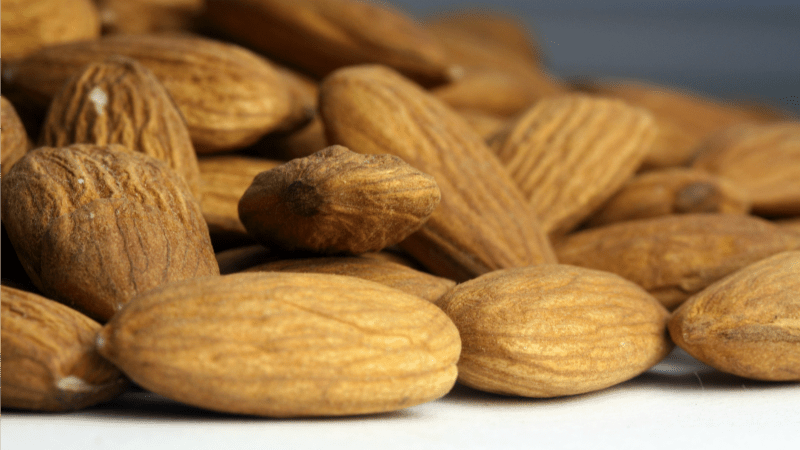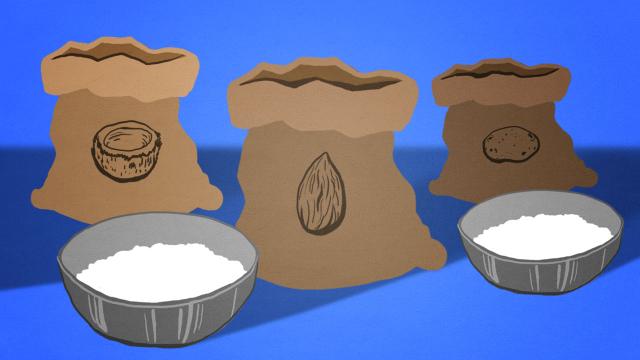Flour isn’t just made from wheat. Not only are there “alternative” grain flours, some are made with nuts, legumes and even spuds. They may seem reserved for the gluten-free, health-conscious set, but when used well wheatless flours can be amazing. We’ve rounded up a few, and some delicious ways to use them.
Illustration by Nick Criscuolo.
Go Nuts With Almond and Hazelnut Flour

Photo by I Nneska
If you feel like getting a little nutty, try almond or hazelnut flour. They’re both highly prized by health nuts for their fibre content and low glycemic index, but what I care most about are all the tasty treats you can make with nut flours. They can contribute textures and flavours you can’t get with the plain stuff.
For everyday baking, almond flour adds a sweet, nutty (duh) flavour and creates a tender, delicate crumb. It also gets some good-for-you fibre and fats in there, which is nice because I need all the nutritional help I can get. If you prefer the flavour of hazelnuts to almonds, rejoice, because everything I am about to tell you about almond flour and meal also applies to hazelnut flour and meal. Nut flours aren’t great fits for everything. You wouldn’t want to try and make a crispy, airy baguette, because the dense, oily, gluten-free nature just won’t play well there. Instead, pick a pastry that would benefit from a denser, richer crumb, like any of the following:
- Brownies: Nuts and chocolate are a natural match. Besides contributing a great flavour boost, both hazelnut and almond flour contribute extra moisture and body, making for an extra fudgy, extra tasty brownie. If you need a recipe, try this one from King Arthur Flour.
- Breading: If you’re looking for a gluten-free way to crisp up some chicken strips, or just want to coat them in a little extra flavour, give them a quick toss in almond or hazelnut flour. The procedure for breading is the same as it ever was; just dip your meat of choice in an egg wash, then roll it around in some nut flour or meal. If you want extra tastiness, mix some cajun seasoning or garlic salt in there.
- Macarons: If you do nothing else with almond flour, you should make macarons. King Arthur Flour has a great, though slightly involved, recipe for the tasty little sandwich cookies. Besides the almond flour, the ingredients are pretty common (sugar, egg whites, cream of tartar and salt) but there’s a lot of whipping, resting and gentle folding involved, so be sure to thoroughly read the instructions.
- Quick Breads and Muffins: There is nothing sadder than a dry loaf of banana bread or muffin, which is why adding nut flour to your batter is such a good idea. The extra fat and moisture makes for a nice and tender crumb, keeping your quick breads of muffins from drying out. Also, almond and hazelnut banana bread sound downright decadent. If you need inspiration, start with these lemon poppyseed muffins from King Arthur Flour or these mini almond pound cakes from Bob’s Red Mill.
If you want to try your hand at incorporating nut flours to some of your favourite recipes, understand that their lack of gluten and oily nature means you have to make some minor tweaks. Bob’s Red Mill recommends replacing around 25-30 per cent or your “regular” flour with nut flour and King Arthur Flour suggests swapping out ¼ cup “regular” flour for a ¼ cup almond, and also decreasing the oil in the recipe by a tablespoon. Throwing an extra egg in there also helps with the structure, so give that a go as well. Finally, make sure you keep your nut flours and meals in the fridge or freezer, as all of that delicious, good-for-you oil can go rancid if not properly stored.
Get Hearty with Besan
Chickpeas (or garbanzo beans) are a creamy, hearty gift that keeps on giving. I’m sure you are all familiar with the wonder that is hummus, but have you heard the good news about chickpea flour? Also known as gram flour or garbanzo flour, you’ve probably encountered this tasty ingredient in Middle Eastern and Indian cooking. This relatively high-protein flour has a slightly nutty flavour, and crisps up like whoa when fried in a bit of oil. This means flatbreads (and pizza crusts and crackers) are perfect candidates for this particular flour.
If you want to get your cast iron skillet in on the action (and why wouldn’t you?) make socca, a large chickpea pancake that Mark Bittman describes as “totally foolproof”. Head over to the New York Times for the full recipe, but it couldn’t be easier. Preheat your skillet in an oven heated to 230C. Mix a cup of chickpea flour with a cup of warm water. Stir in some salt and pepper and a of couple tablespoons of olive oil. Remove your heated skillet and (carefully) swirl some olive oil around in there. Fry onions and rosemary in your hot pan, and pour the batter directly on top. Bake it all together until set and then broil for gorgeous crispy spots.
If you could only make socca with chickpea flour, that would be enough, but it has more gifts to give. It can be used to thicken soups, sauces and stews, and makes a great binder for veggie burgers (a couple tablespoons should do the trick), and can even be used to make a delicious, decadent fudge (which you can learn how to make by watching the video above).
Rice (Flour) Is Nice
Rice flour is simply ground-up, raw rice, and can be made from either white or brown varieties. If you’ve ever perused an Asian market you may have seen two types of rice flour: glutinous and non-glutinous. Neither contain any gluten; “glutinous” just means that stuff is sticky. Perhaps the most fun application for glutinous rice flour (also called “sweet rice flour”) is mochi.
Mochi is deceptively easy to make, and only requires four ingredients: rice flour, water, sugar and cornflour. Just mix the rice flour and water in a bowl and steam for 20 minutes. After that, stir in the sugar over heat, letting it melt and incorporate completely. Transfer the dough to a baking sheet that is liberally coated in cornstarch (coat your hands too) and roll it out, cut it into pieces, or wrap it around ice cream and freeze. If you don’t have a steamer, you can also use the microwave, as explained in the video below.
Moving on to savoury applications, rice flour makes excellent noodles. Though it’s a slightly involved process (you’ll need two people to make the dough) the ingredient list is short enough (rice flour, water, oil and tapioca starch). If you want to try your hand at it, check out Vietnamese Home Cooking, via Epicurious. Rice flour also makes for a light, crispy batter, and this one from ChefSteps is out-of-this world.
This tempura-style batter is infused with carbon dioxide for the laciest, lightest, crispiest coating you’ve ever crunched down on. You’ll need a whipping siphon, but these perfect, golden-brown veggies are a pretty good payoff if you ask me.
Perfect Your Bread with Potato Flour
Potatoes are a pretty perfect food, and potato flour continues the tradition of potato awesomeness by being pretty helpful in the kitchen. Made from dehydrated potatoes, this flour is particularly good at attracting water, making it great for tender breads, waffles and pancakes. It also tastes like potatoes, which is a good thing.
To use potato flour to make tender tasty breads, follow these guidelines from Barry Farm:
- For general baking: Replace up to 1/4 of any wheat flour in a recipe or substitute 5/8 cup potato flour for 1 cup all-purpose flour.
- For yeast breads: Replace up to 1/6 of the wheat flour in a bread recipe or substitute 5/8 cup potato flour for each cup of all-purpose flour.
For a super soft hamburger bun, try this recipe from King Arthur Flour, which uses ¼ cup potato flour for 3 cups all-purpose. The potato flour makes the dough thicker and easier to handle, letting you craft a bun that holds its shape. One tip: when adding potato flour to bread recipes, be sure to mix it with your “regular” flour first; adding water directly to it turns everything into a gloppy, lumpy mess.
Potato flour is also an excellent thickening agent. To thicken soups (try potato soup for soup inception), stews, and sauces, just add a tablespoon at a time until you reach your desired viscosity.
So there you have it: a whole bunch of uses for some of the weirder flours out there. Use them well, and you’ll get great results, and they will be worth their (often higher) price tag. Experiment, and enjoy the delicious results.

Comments
One response to “Your Guide To The Strange World Of Alternative Flour”
strange thing about flour is that a ton of anything is 2240 pounds but a ton of flour is 2000 pounds.
Not sure why, I said it must be self raising flour.
The metric system fixed this anomaly as tonne of anything is 1000 kg.